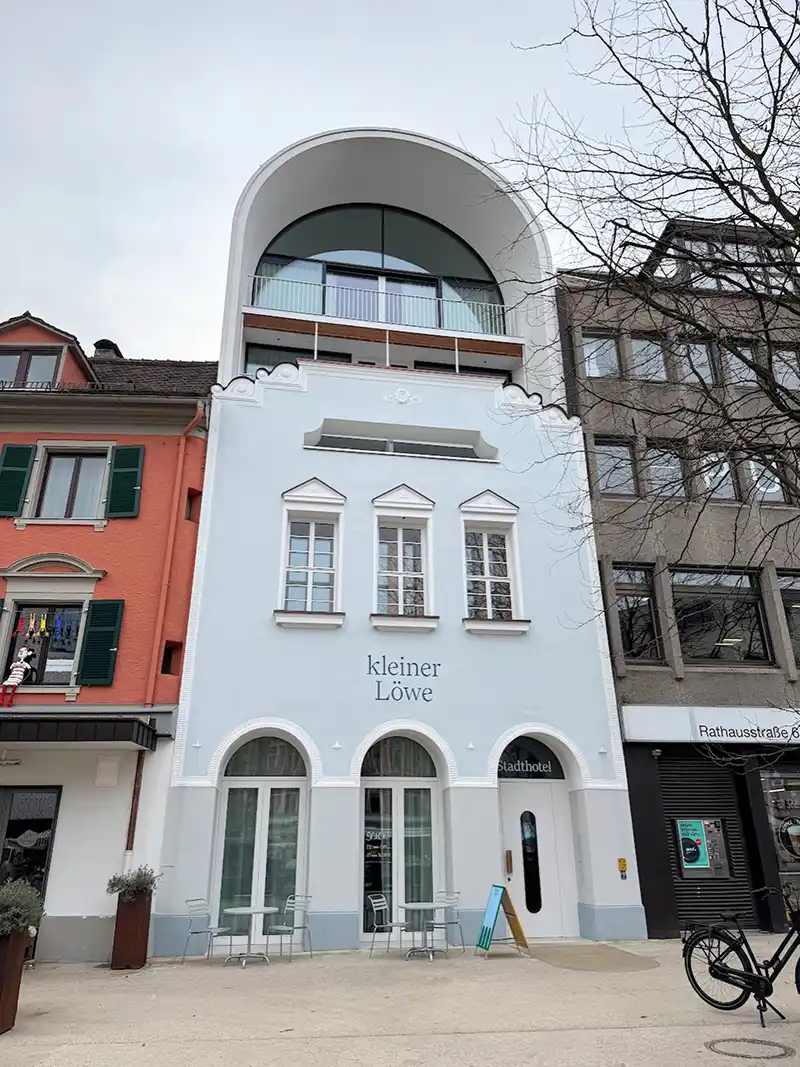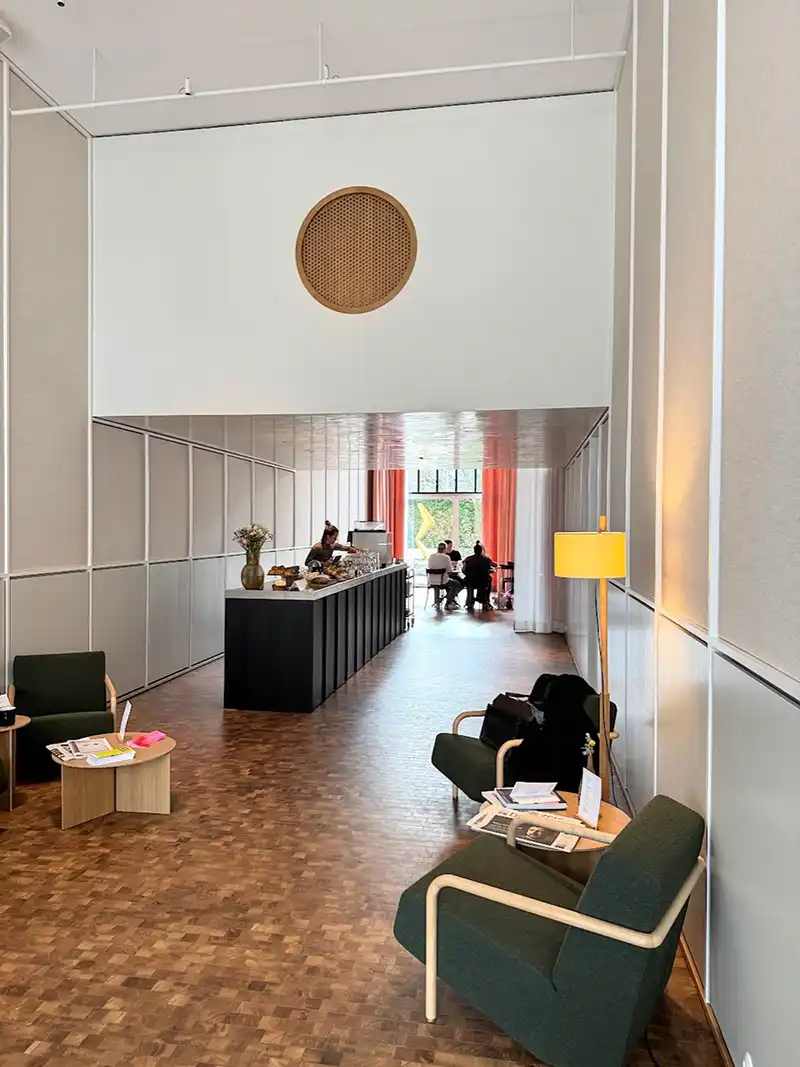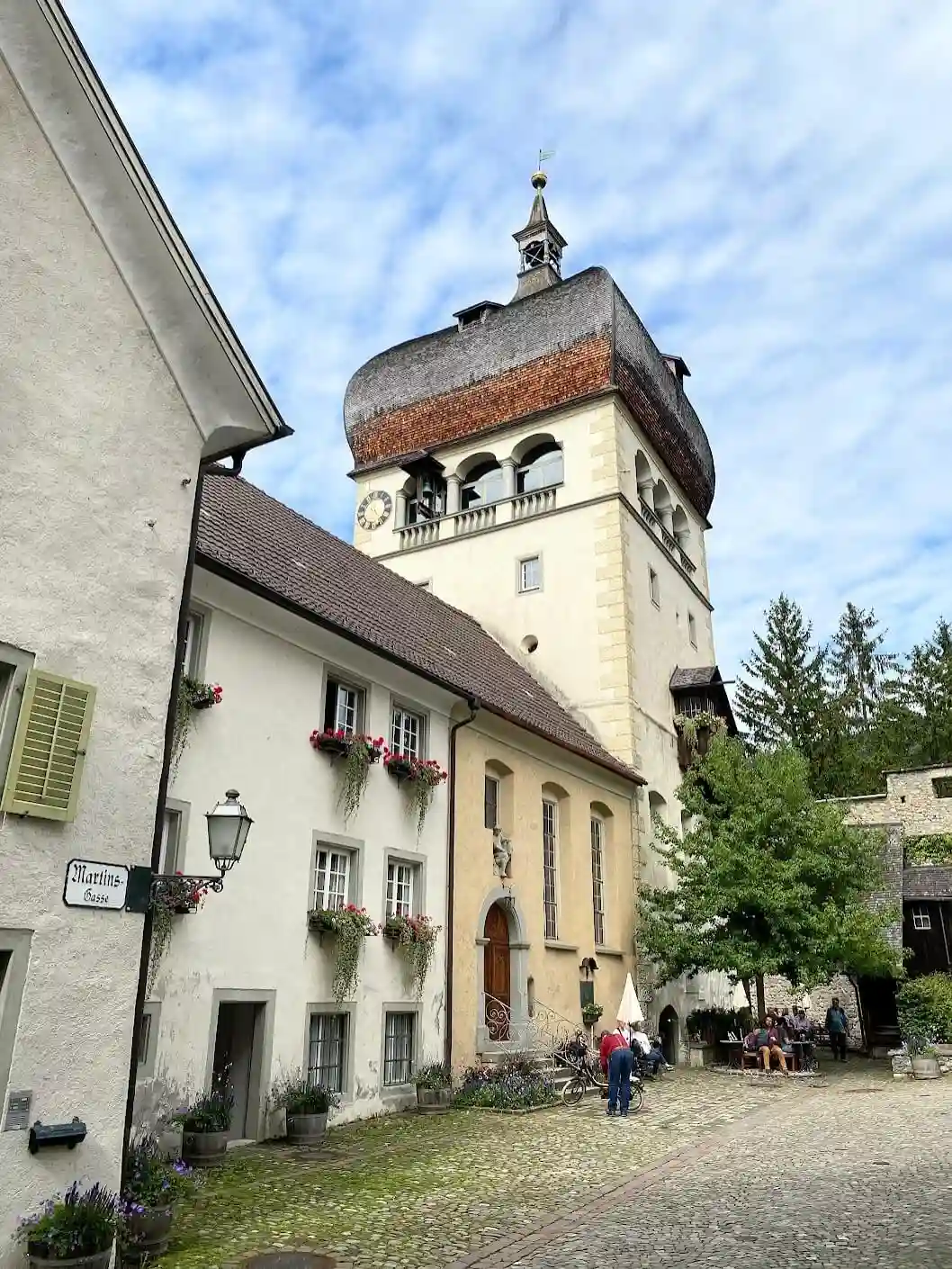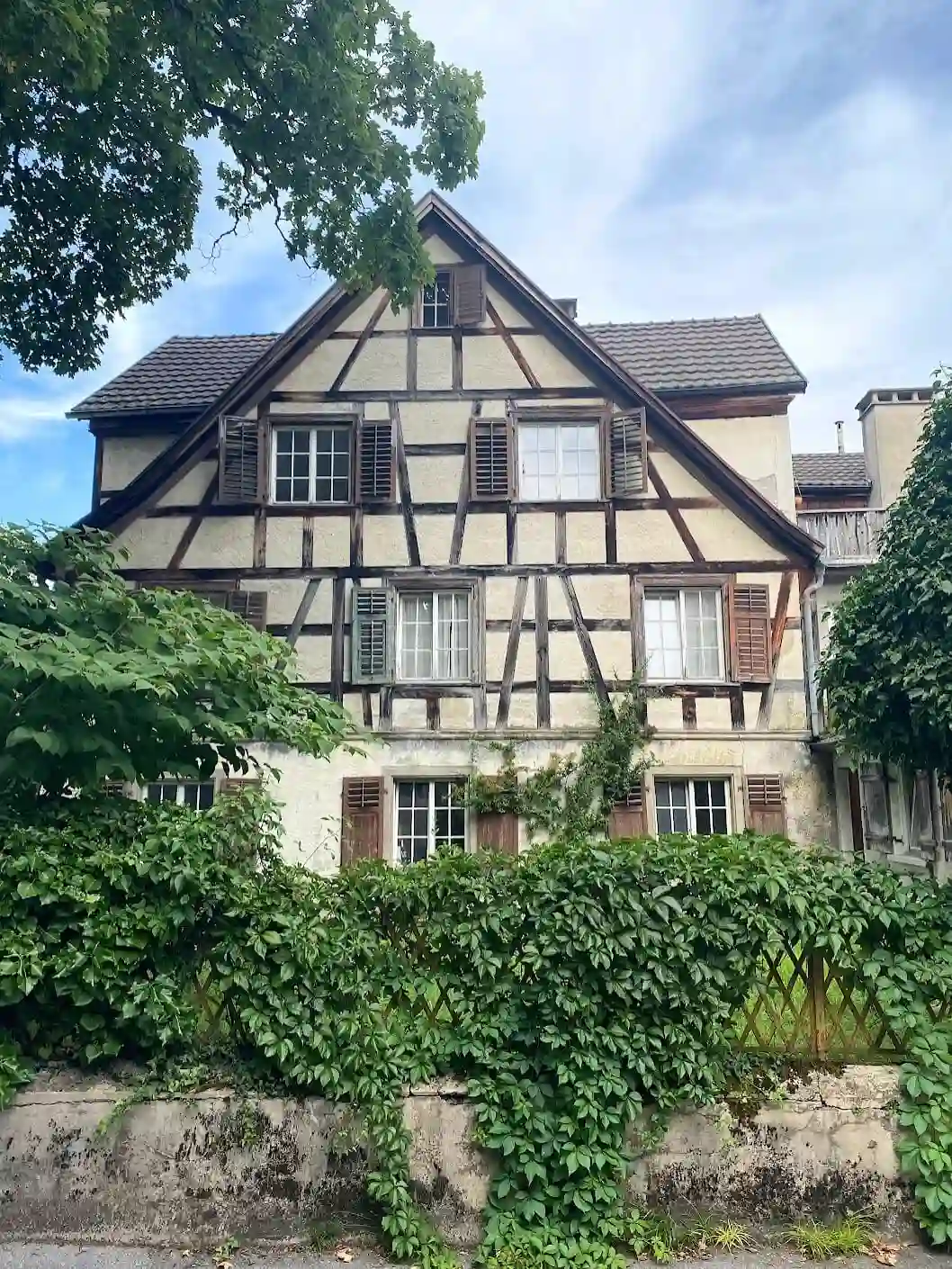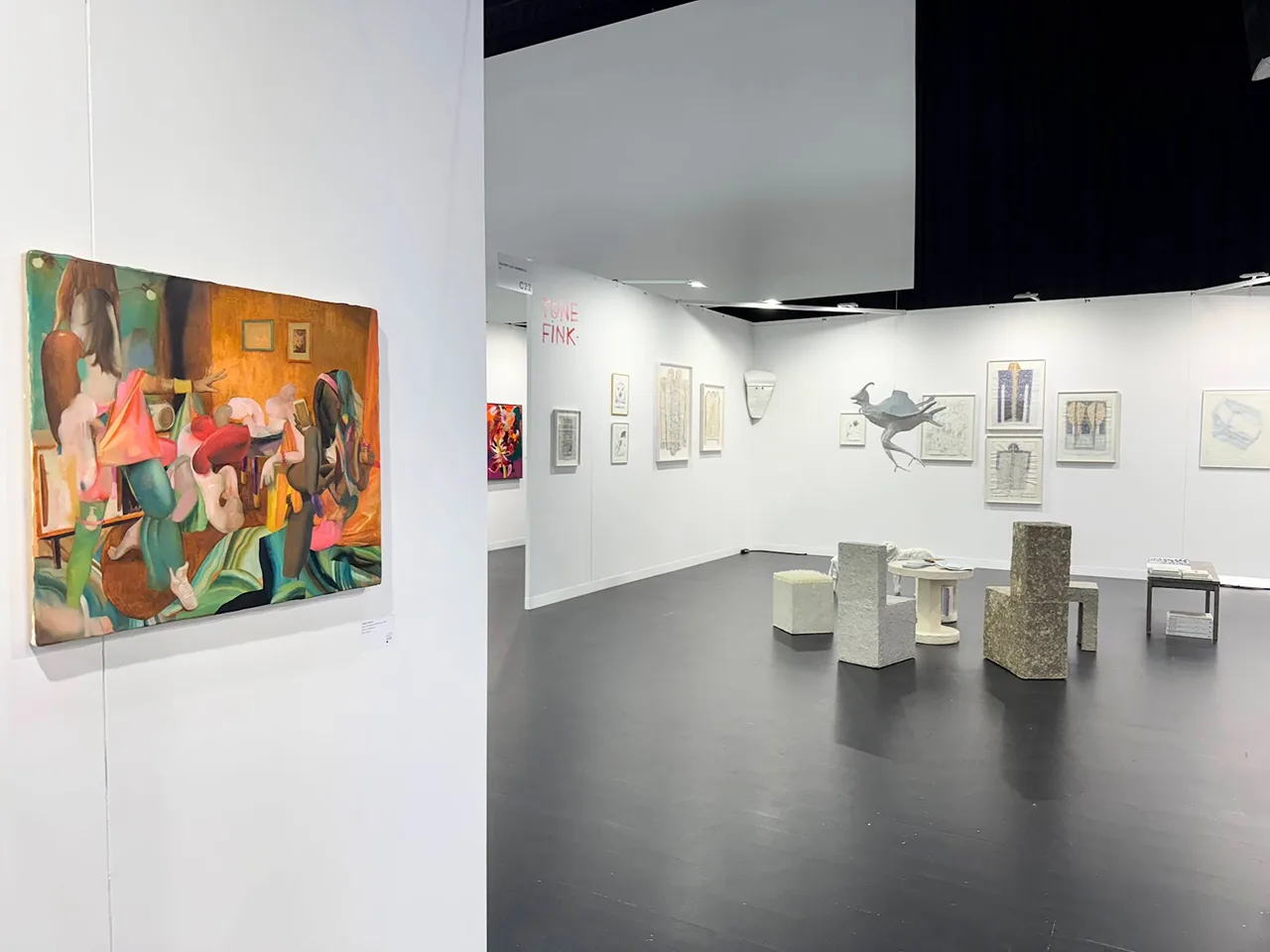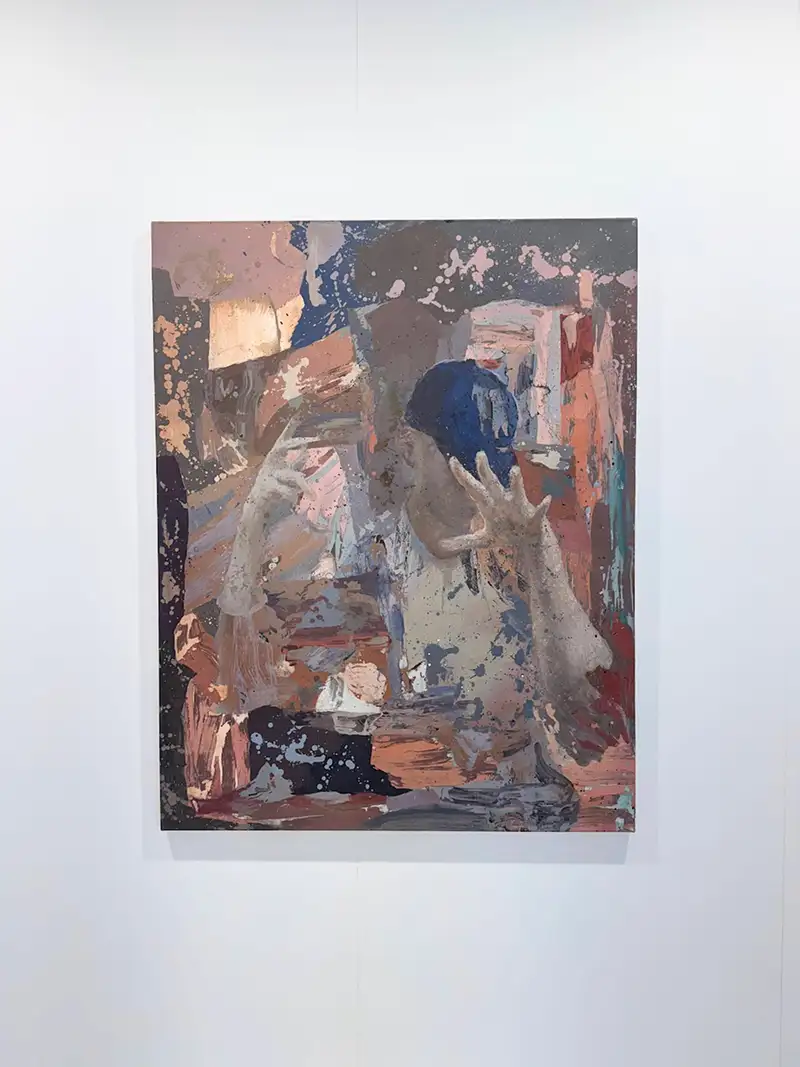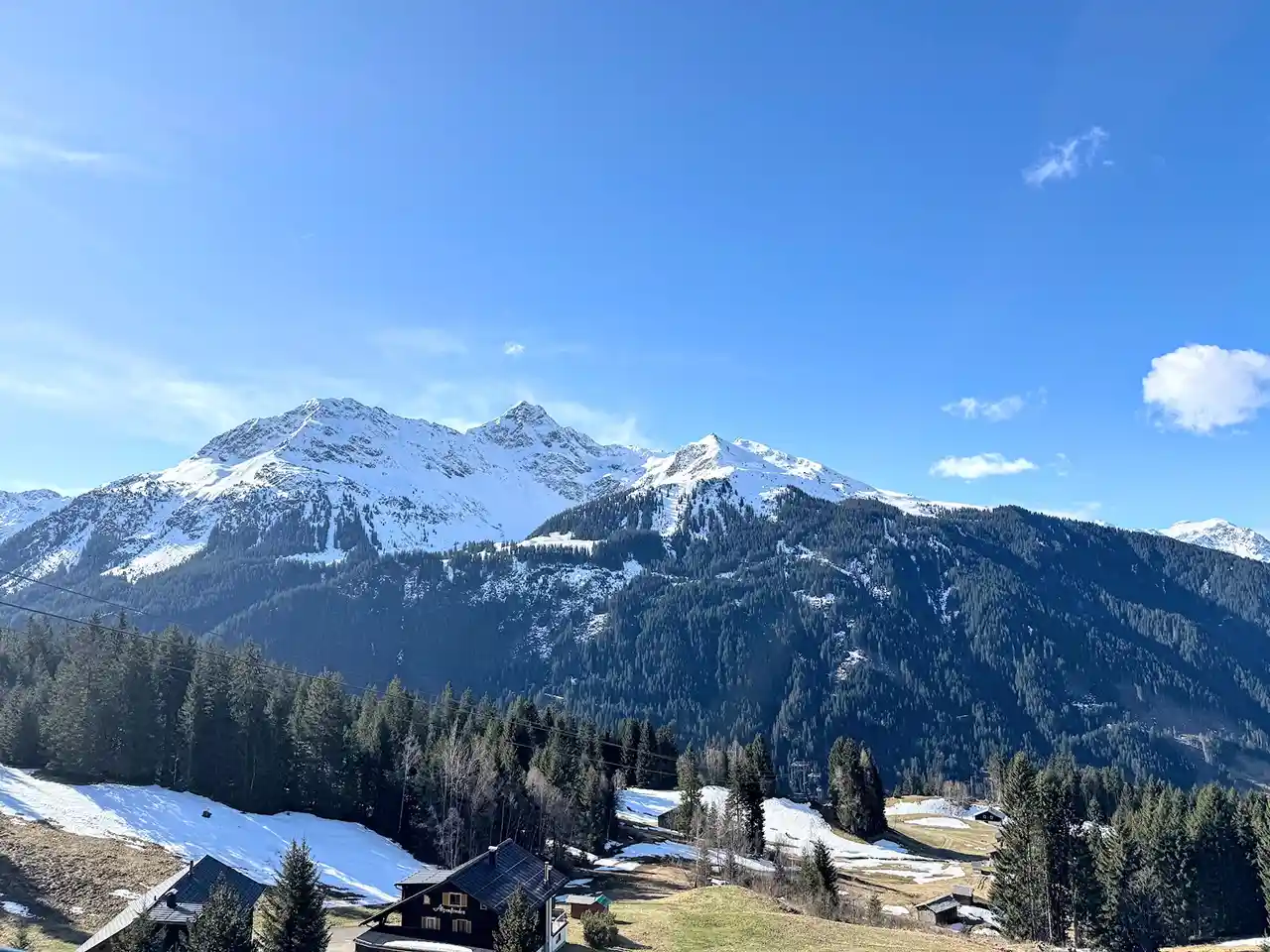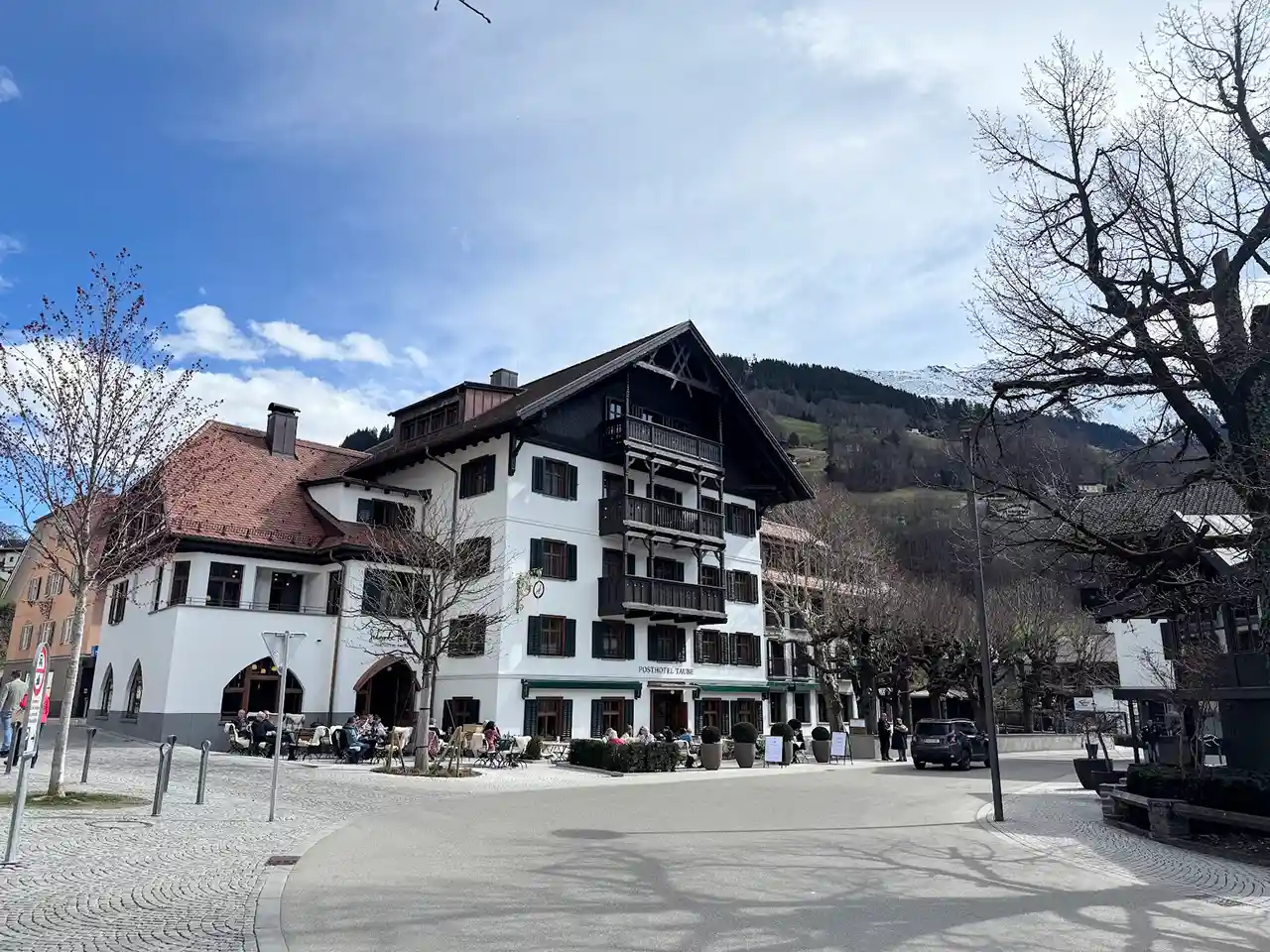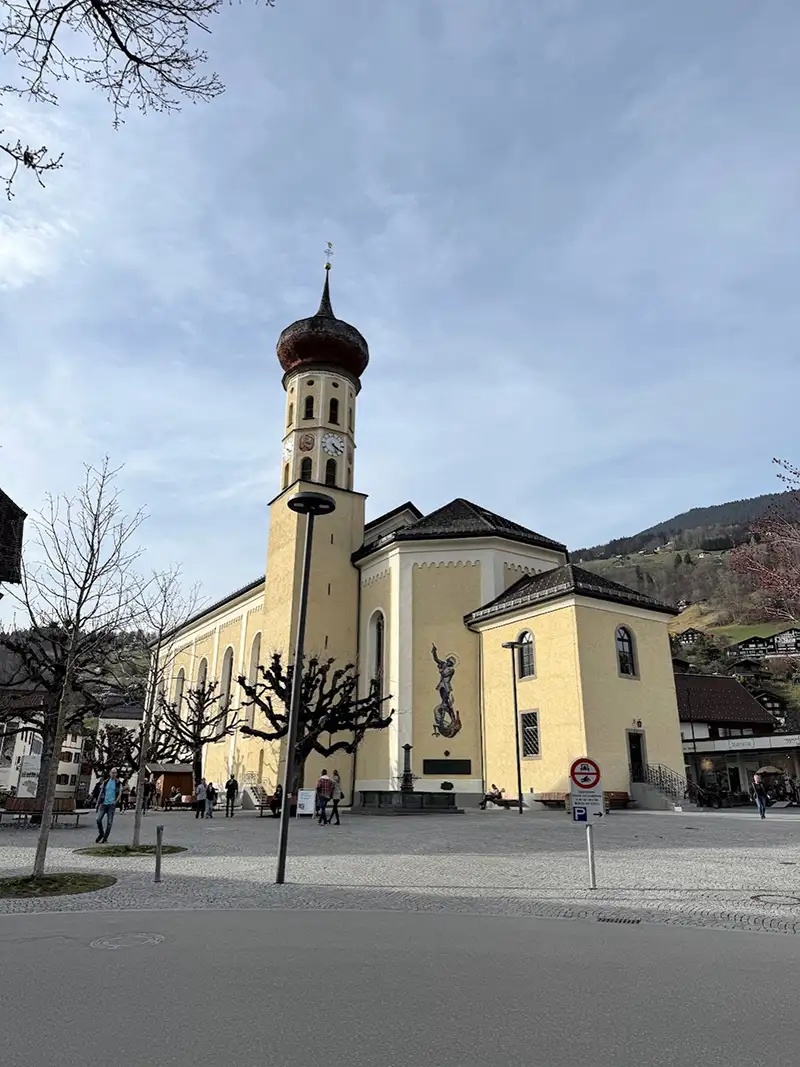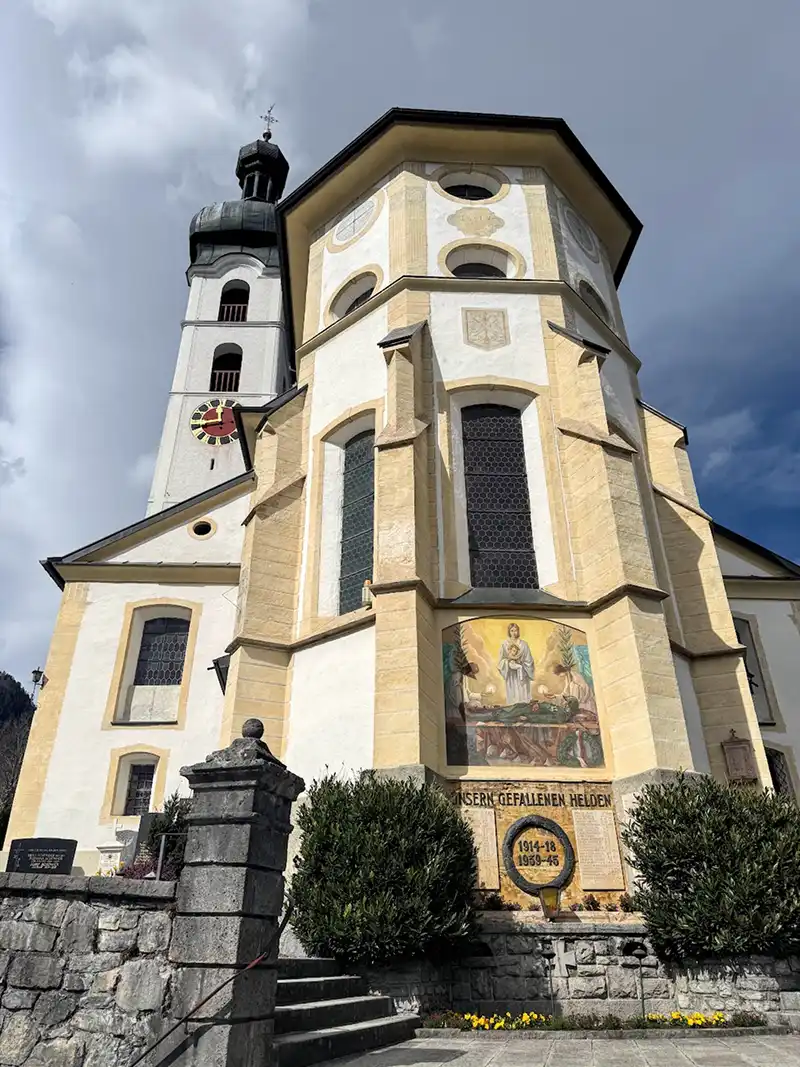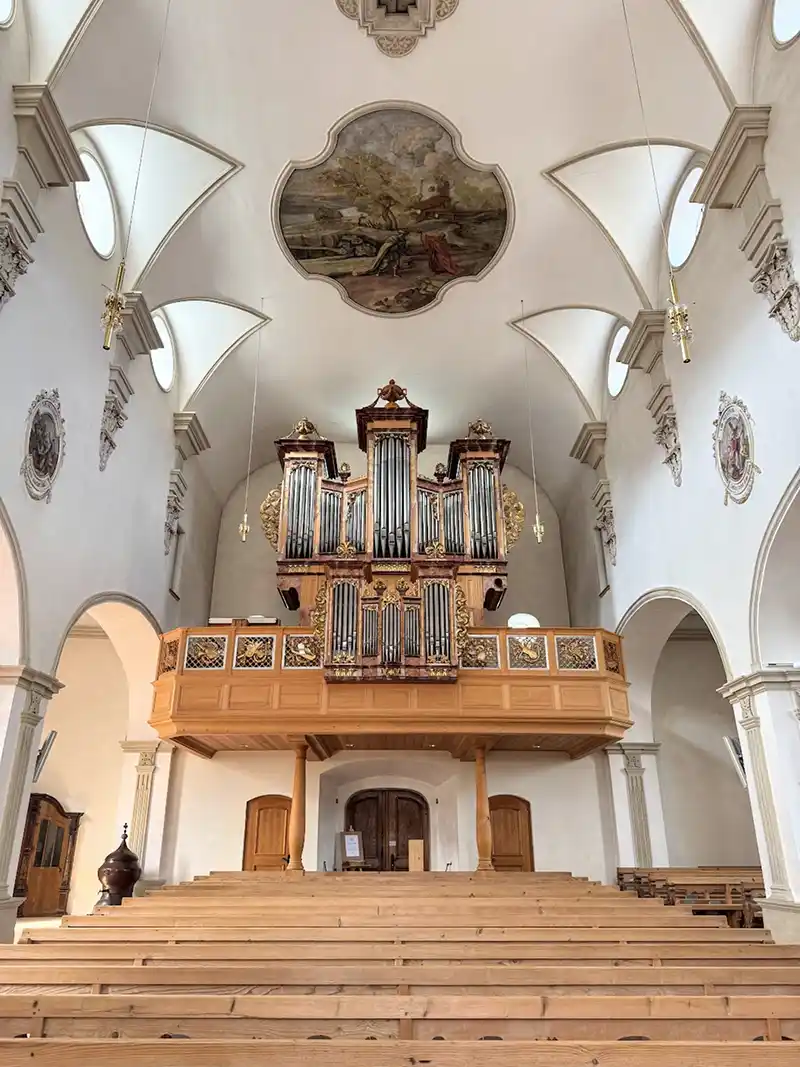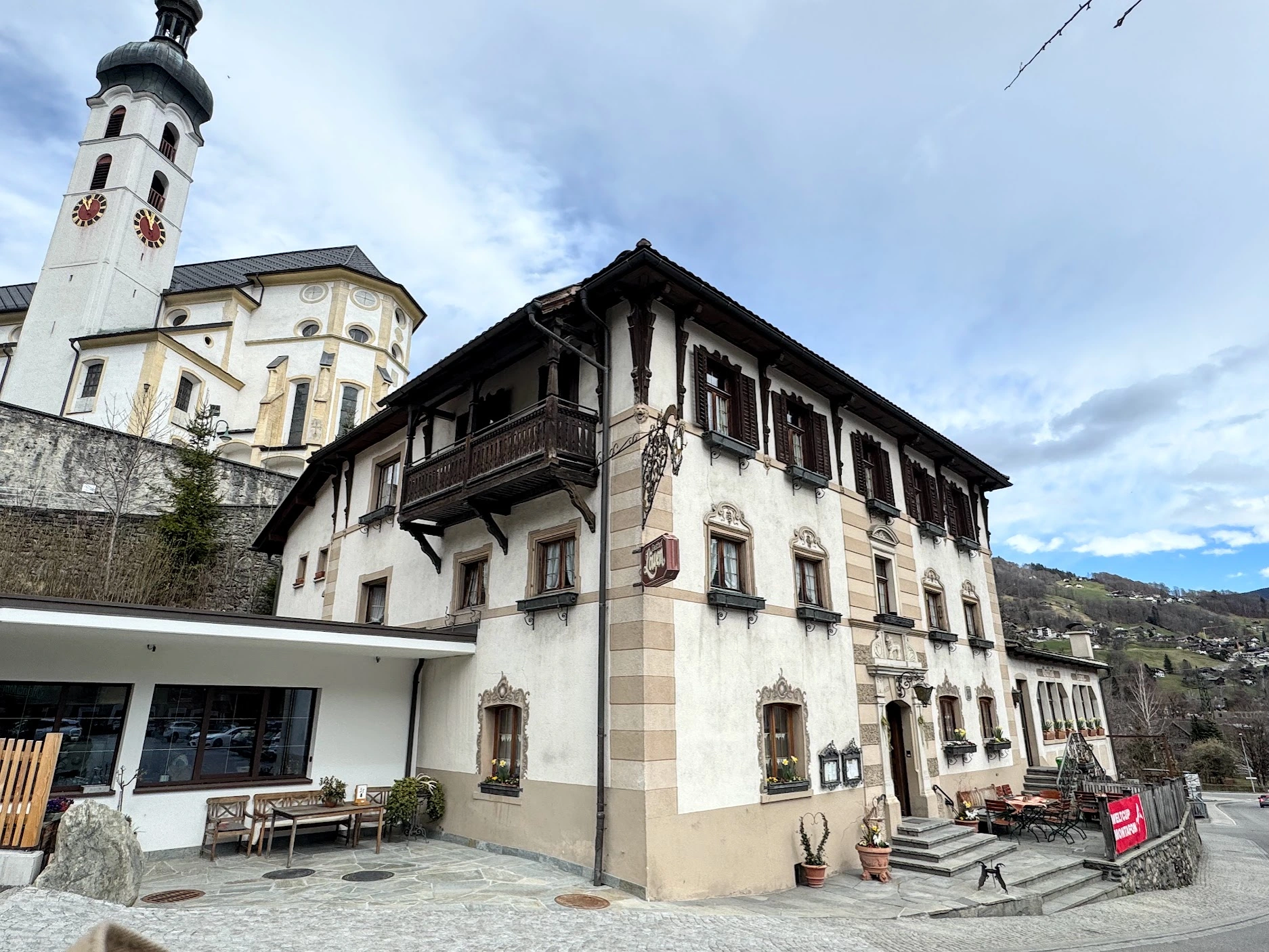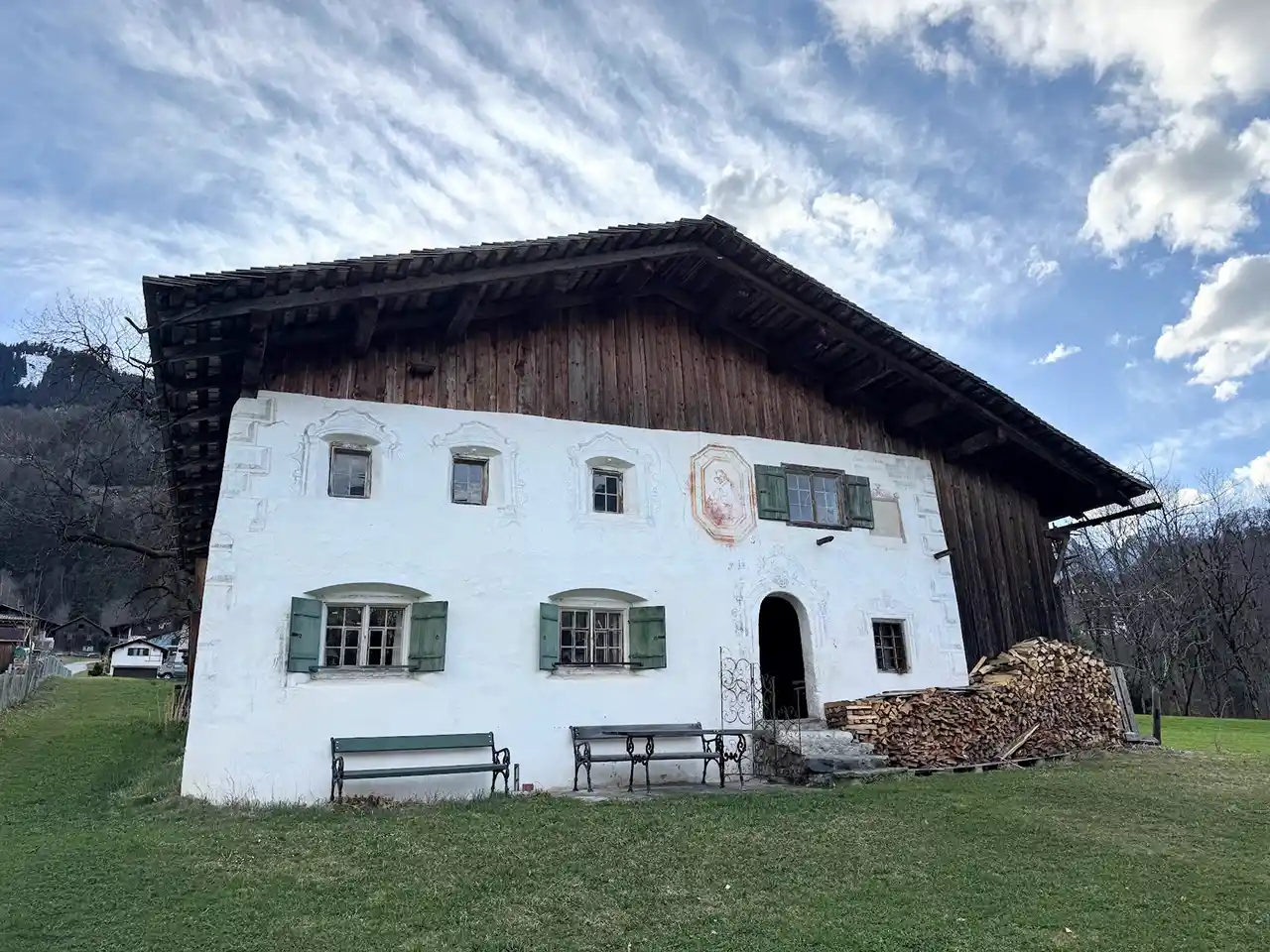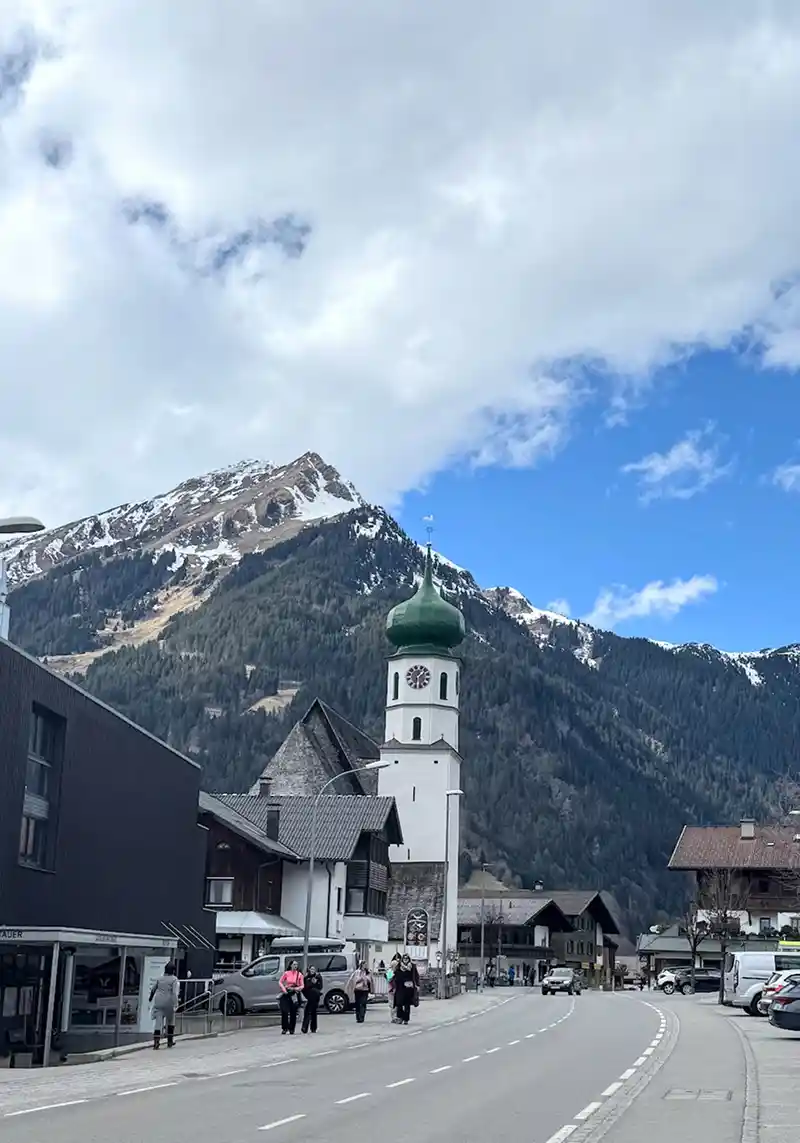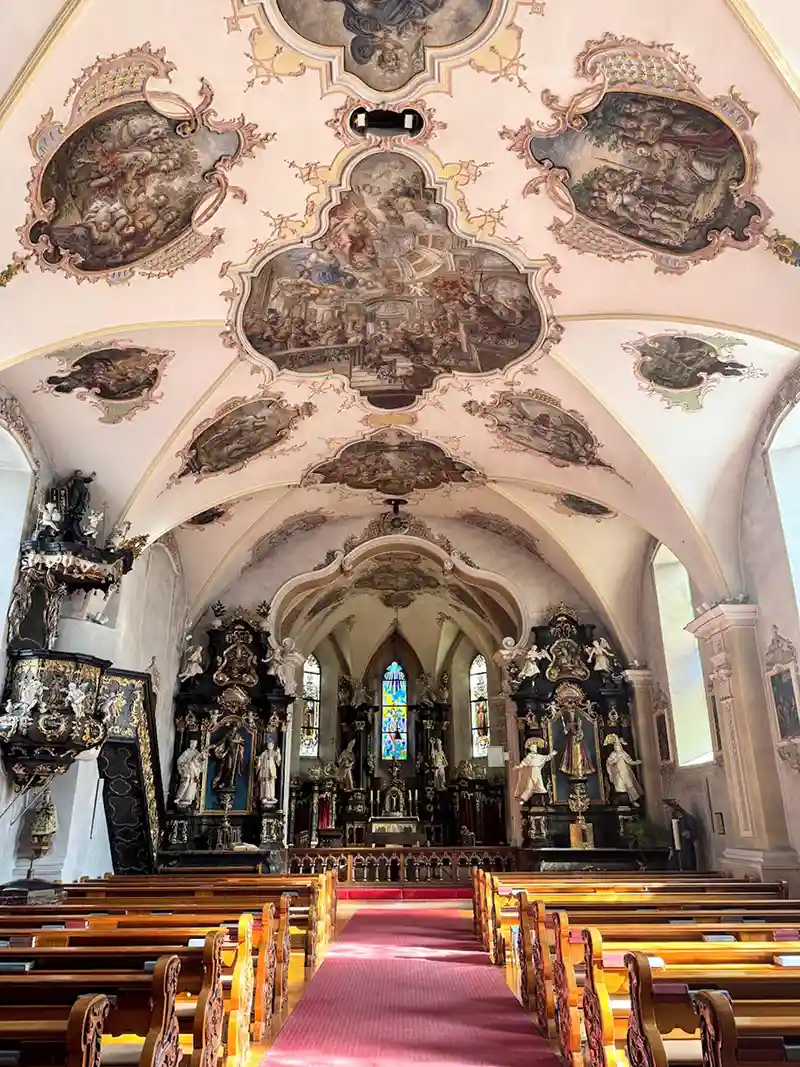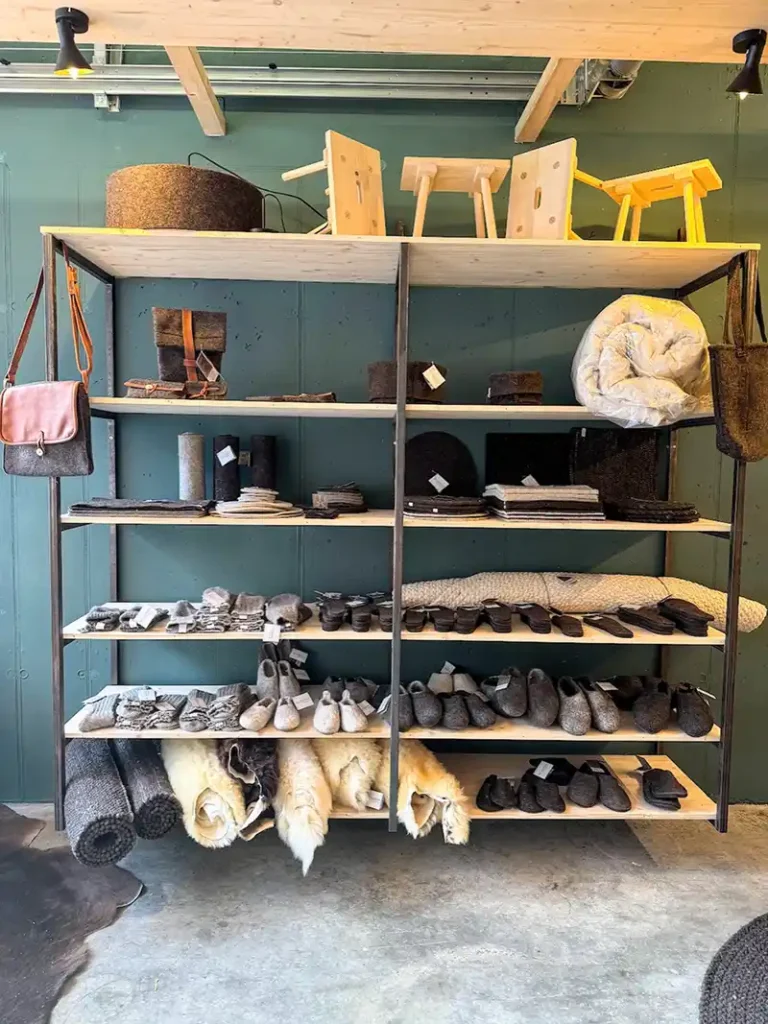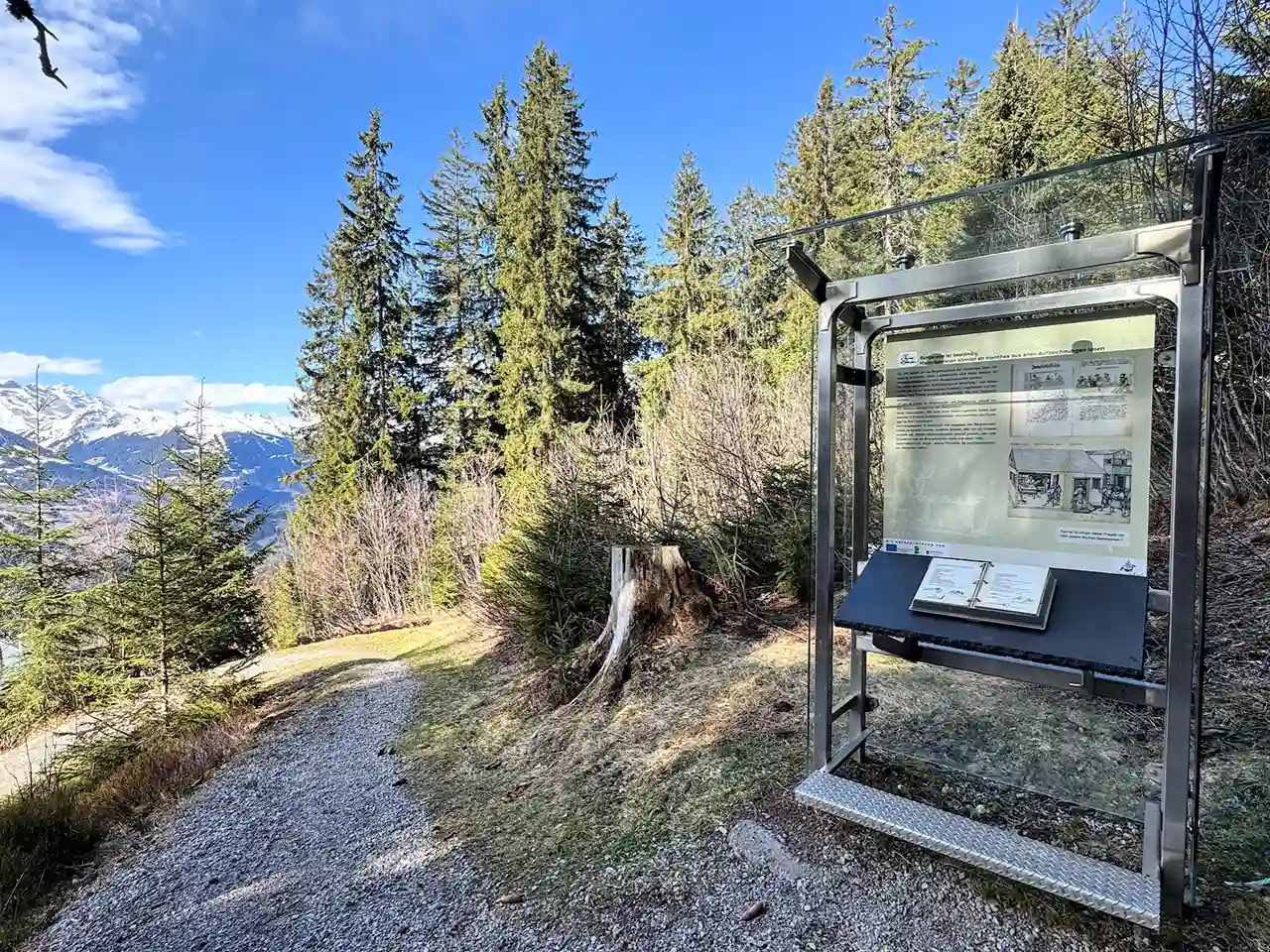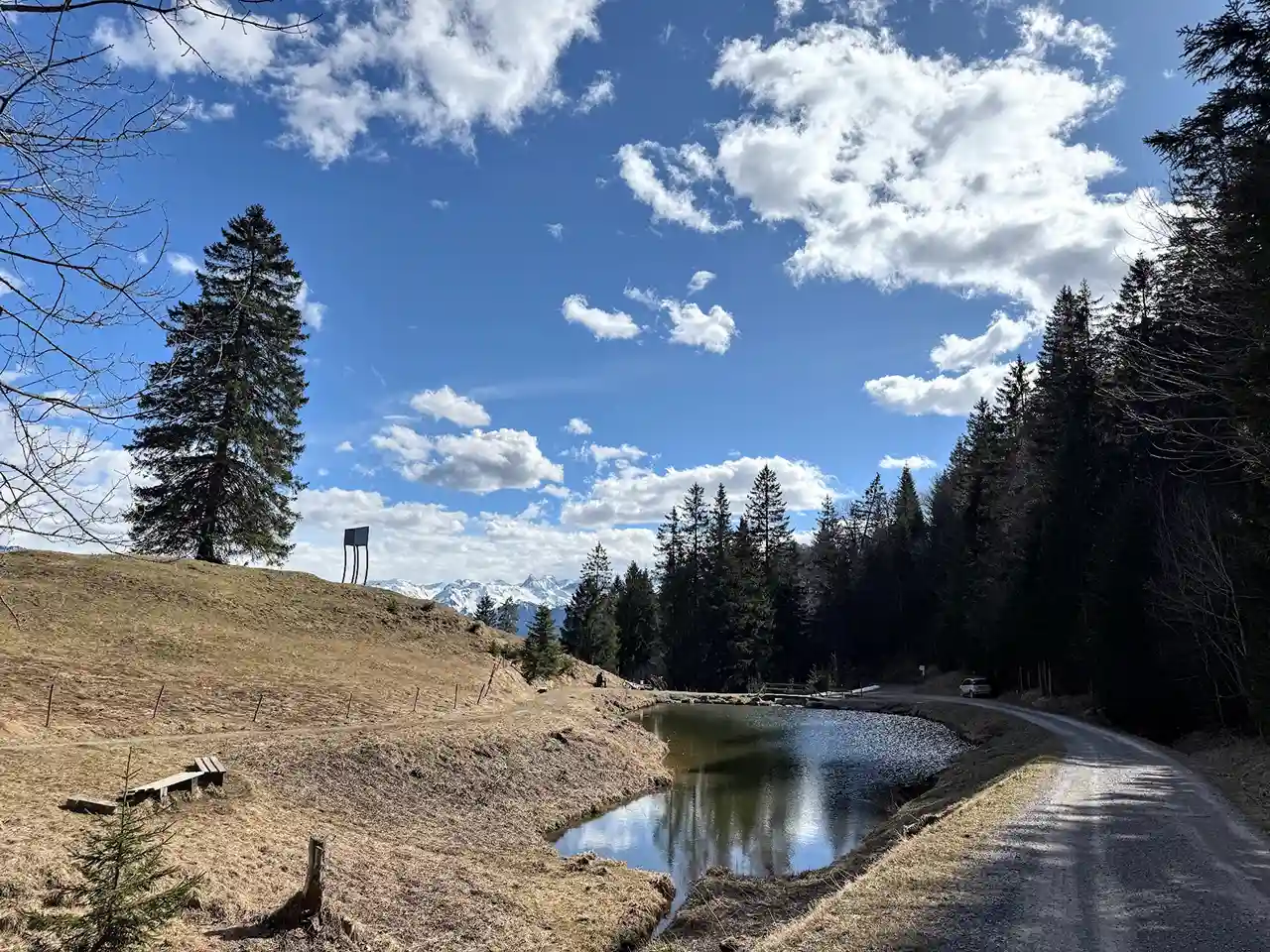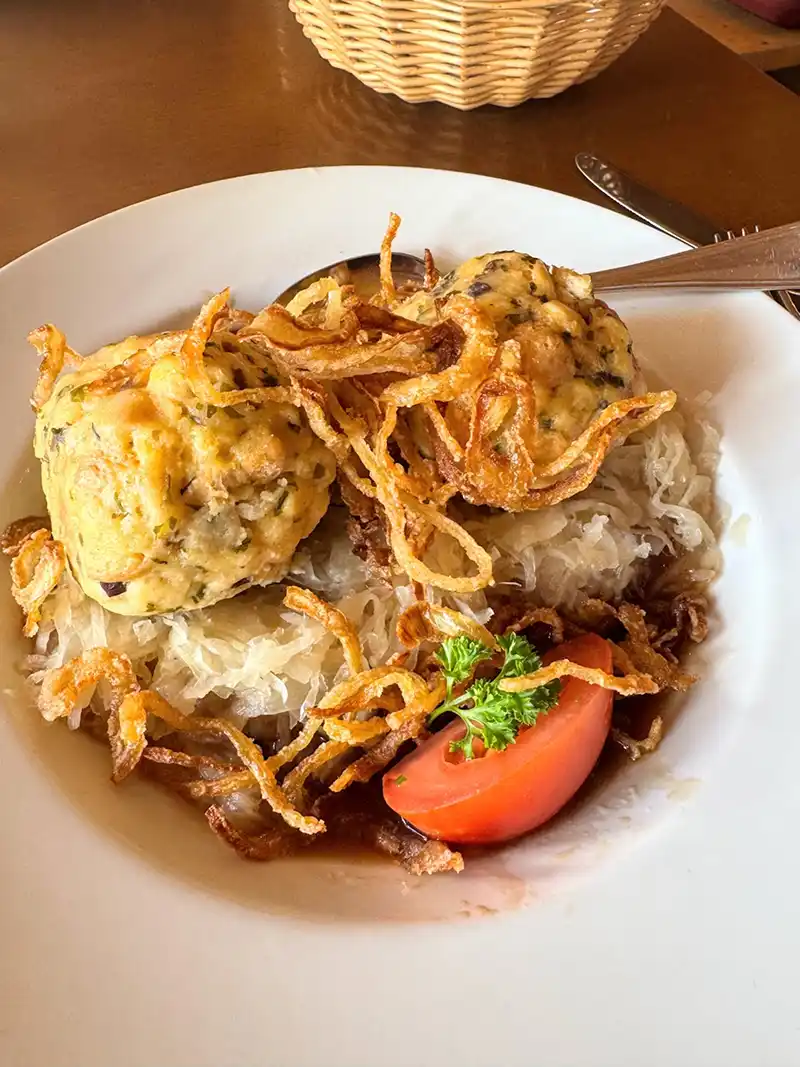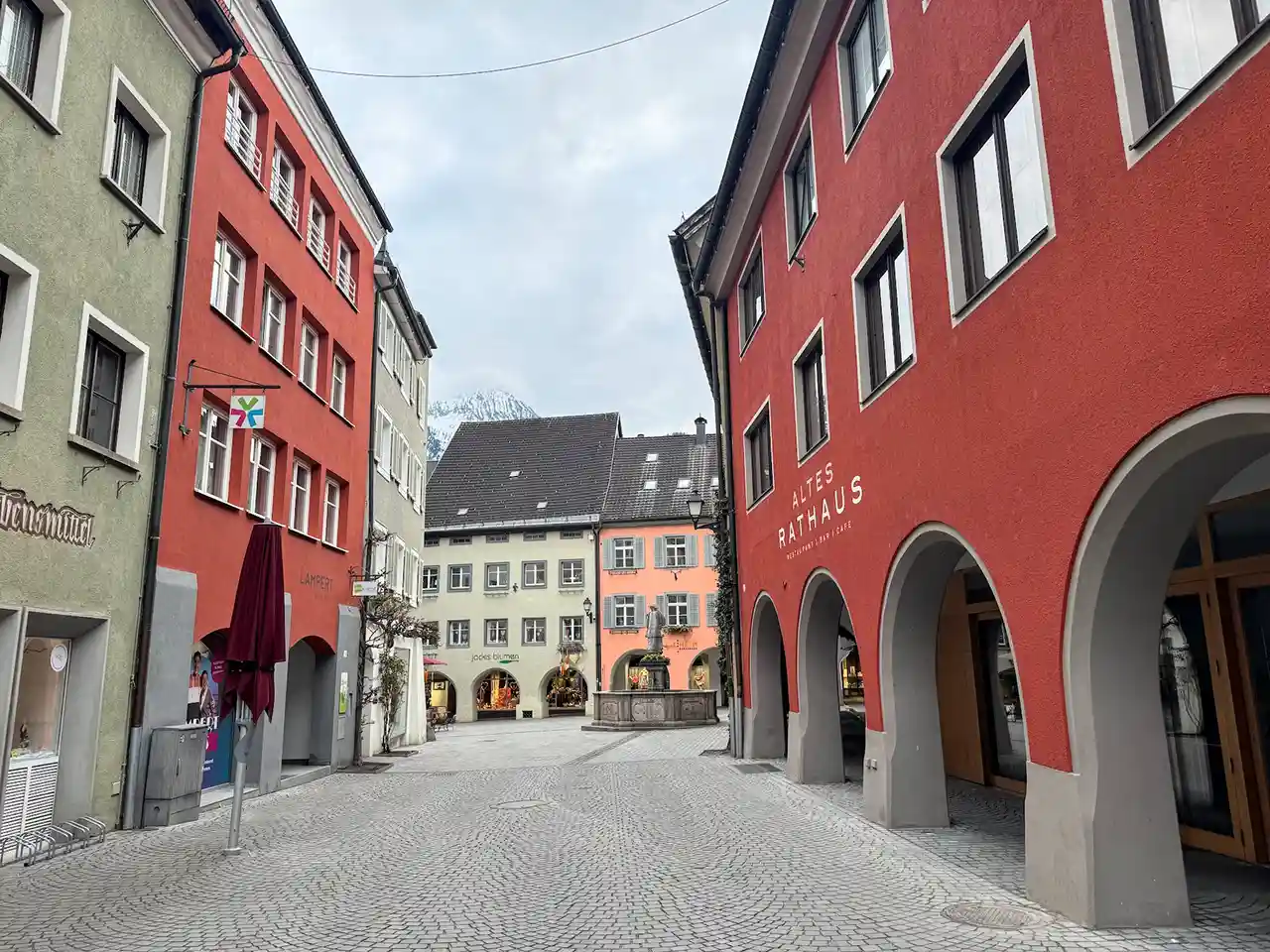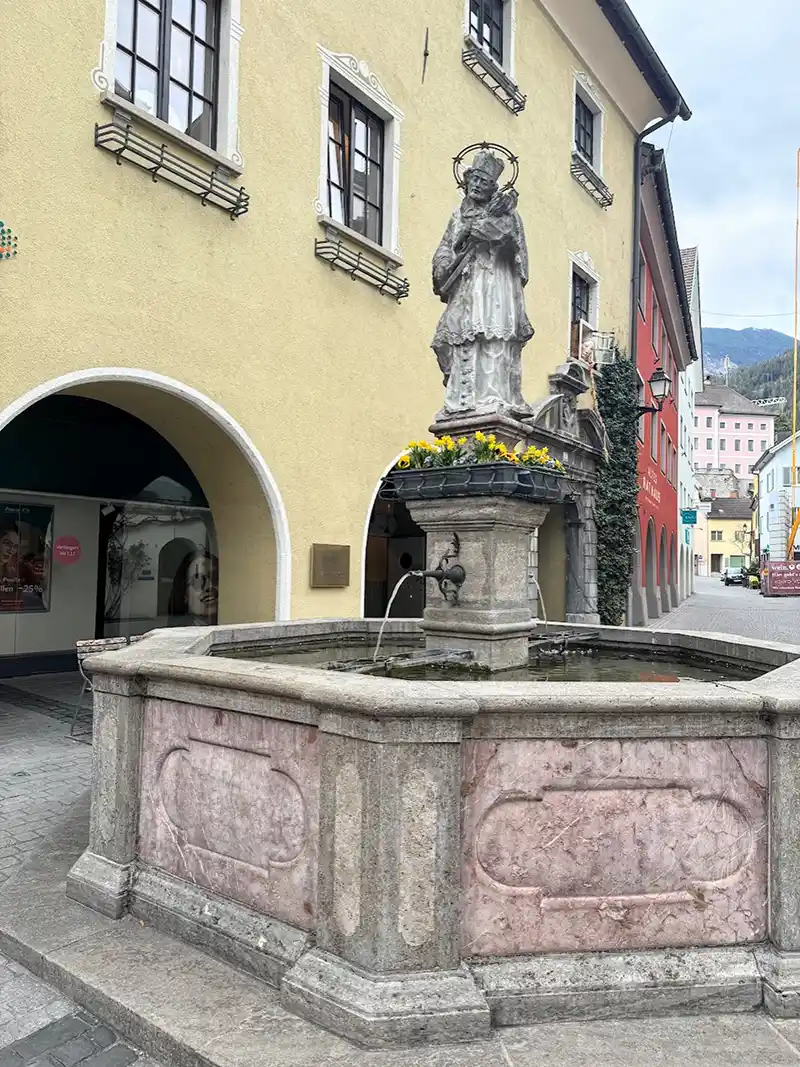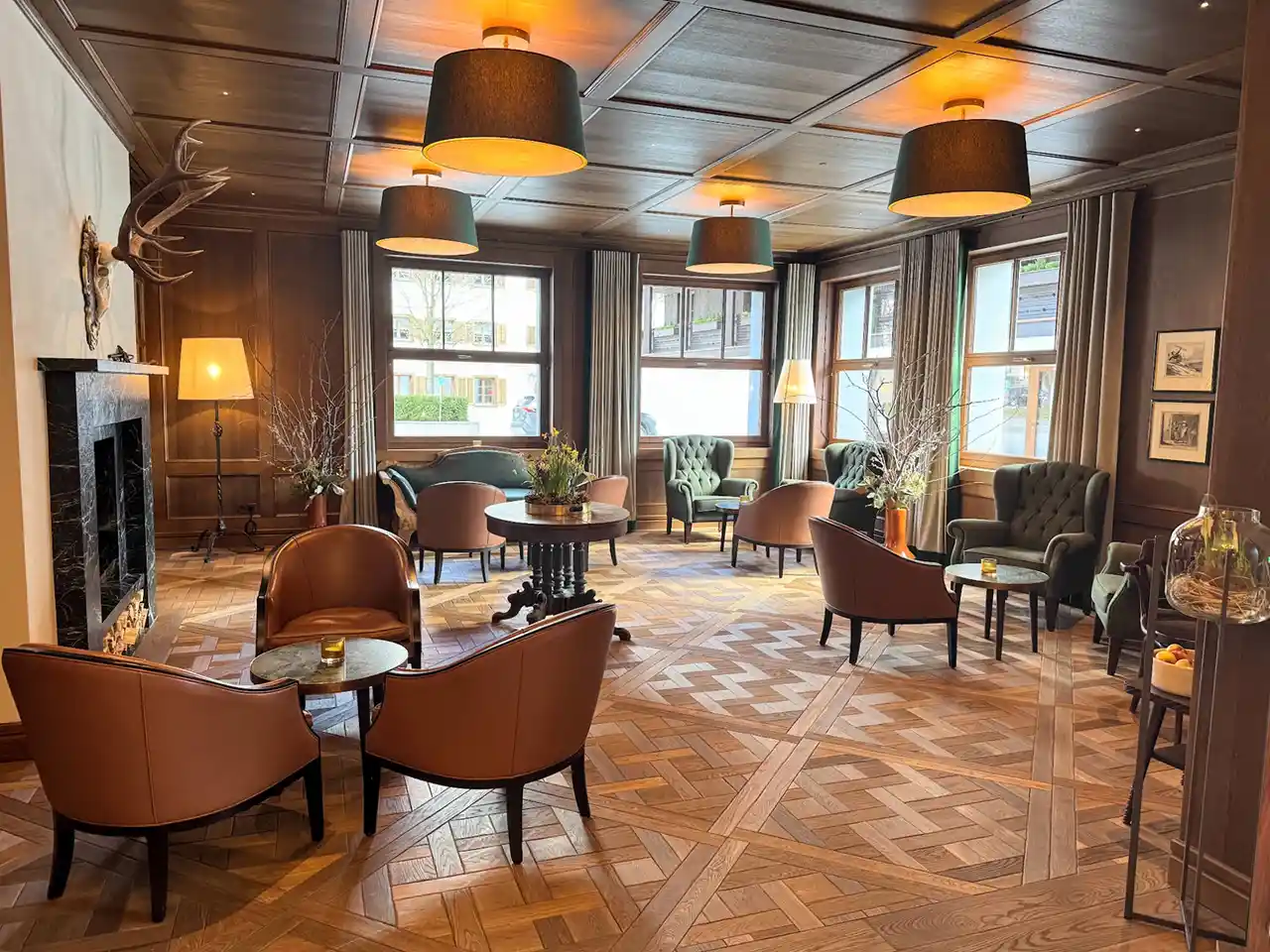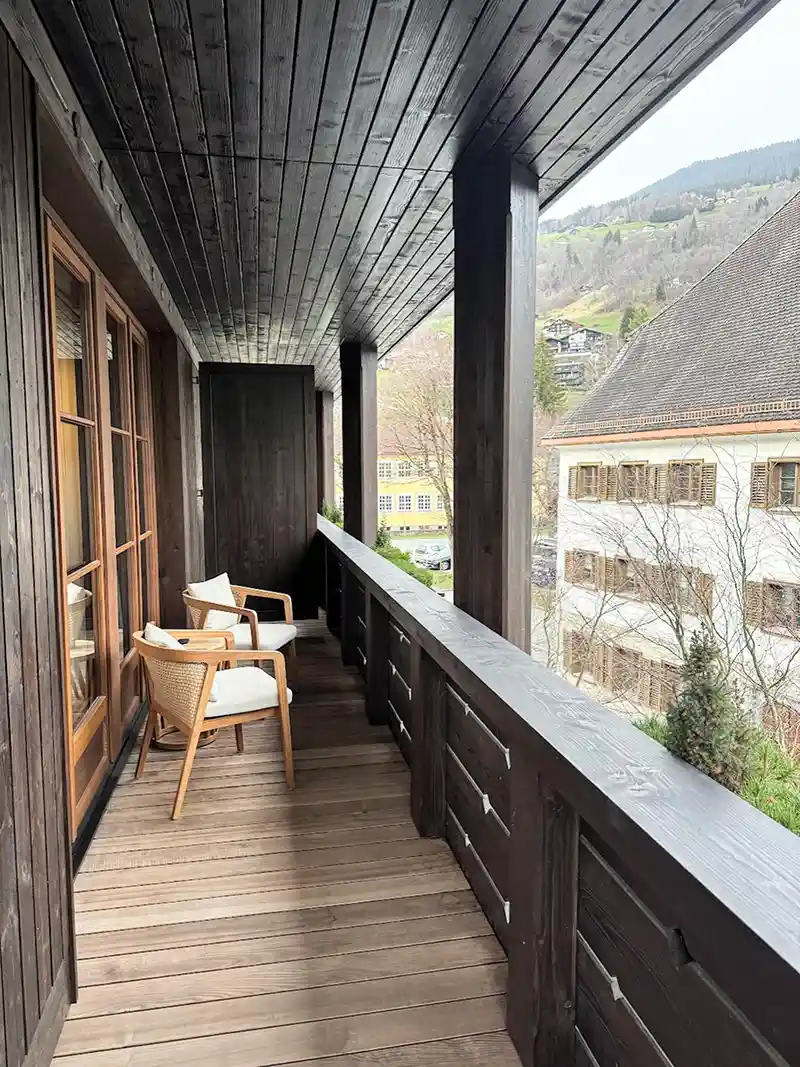Although famous as a winter sports destination, Vorarlberg is a hidden gem for art lovers worth visiting all year round. With its elegant towns like Bregenz and captivating Lake Constance, Vorarlberg has the charm of a historical touristic destination. However, being renowned as a contemporary architecture hub, and with its innovative approach towards sustainability, the cultural landscape filled with art installations, and new contemporary art initiatives like STAGE Bregenz, you’ll return to it over and over again. Just as I am doing.
Vorarlberg’s Cultural Landscape
I started my last visit to Vorarlberg at an elegant Kleiner Löwe hotel located right in the heart of Bregenz. During a breakfast with a group of journalists and Verena Konrad, a director of the Vorarlberg Architecture Institute, I realised the architectural history has been written in a moment in that Austrian region. Since the 1960s, architects started working together with local craftsmen to create numerous beautiful buildings in Vorarlberg. By using the vastly accessible material in the area – wood, they started not only shaping the new cultural landscape of Vorarlberg, but also an exquisite local taste in design and architecture.
Fast forward sixty years later, the westernmost region of Austria is home to around 150 architectural companies which employee around 4000 people. I checked the statistics: the region is home to a bit more than 400,000 inhabitants, meaning there is one person working in architecture per 100 inhabitants in Vorarlberg.
This made me compare it with the Dutch Golden Age in art during the 17th century when in wealthy cities like Amsterdam or Haarlem, there was one painter per 1000 inhabitants. Can we confidently say Vorarlberg is experiencing its architectural Golden Age? I became even more sure about that when I remembered some of the contemporary architecture I saw in the region during my previous visits.
Watch my video below to see some of them:
Bregenz
Being in Bregenz a few times already, I decided to spend my morning as one usually does in places that grew to your heart: by wandering around some of their favourite areas. Bregenz has a surprisingly balancing combination of old and new, traditional and progressive.
I strolled around the cobbled streets of its old town which witnesses its long history. The old doors of the Stadttor make you imagine travellers passing through them for centuries. While at the chapel of the bulb-shaped Saint Martin Tower, surrounded by 14th-century wall paintings, you can almost hear the medieval choir singing during the Sunday mass.
But again, these remnants of passed time are interrupted by the small shops showcasing the local’s creative spirits. I made a mandatory stop at a wonderful Xocolat shop which shelves were filled with chocolate Easter bunnies this time.
⤷ Read more: 10 Things to do in Bregenz
STAGE Bregenz
However, the main reason for my trip to Vorarlberg was to visit the STAGE Bregenz. It comes as no surprise, that the region that cherishes creativity so much, has started a new event to serve as a platform for visual arts. Organised at the iconic Festspielhaus next to Lake Constance in Bregenz, it’s a contemporary art fair which aims to be as sustainable as possible.
I was so impressed by the diversity of art forms represented at the fair. From traditional paintings and statues to light installations and product design, the styles of these art forms spanned from figurative to abstract. I also loved how accessible the STAGE Bregenz was. Contemporary art fairs tend to cater to a very narrow audience of art professionals and dedicated collectors. However, that wasn’t the case with this one. The exhibited artwork was displayed in a very approachable way, and both people working at the fair and the gallery owners were nothing less than friendly and open to sharing their knowledge and telling more about the displayed art, making everyone welcome.
That’s something that puts the STAGE Bregenz aside! It’s a contemporary art fair with carefully selected great-quality artwork, providing a wonderful overview of current ideas and trends in art. But, that’s all presented in a way that makes it interesting to everyone. It gets 10/10 from me!
⤷ Read more: Best Exhibitions in European Museums in 2025
Montafon
After being mesmerised by fantastic contemporary art at STAGE Bregenz, I took a train and left for the eastern part of the Vorarlberg Region. It was the area I hadn’t had a chance to visit during my previous visits, so I was thrilled to explore Montafon. After around an hour-and-a-half-long train ride, I arrived at a valley surrounded by tall snow-covered mountains.
To paint an image of Montafon in your mind, just close your eyes and imagine the most beautiful Alpine landscape. Wherever I turned, it seemed as if someone had scattered typical wooden houses on the green hills below the white mountain peaks. Built of a combination of wood and stone between the 15th and 20th centuries, these typical edifices are known as Montafonerhaus.
The region is a skiing paradise and when I exited a train at Schruns, I got myself surrounded by skiers slowly waddling from one foot to another, ski booths on their feet and skies in their hands. It felt as if I arrived at the wonderful winter countryside.
⤷ Read more: What to see in the Vorarlberg Region
Schruns
My base for the next couple of days was the village of Schruns. Its historical centre was a nice place to slowly stroll around and enjoy the slow-paced life. An aspiring writer within me was thrilled to learn Schruns was frequented by Ernest Hemingway and his family. This is where he spent his holidays in 1925 and 1926. He mentioned that Austrian village in his book, A Moveable Feast. A bronze statue at the town centre commemorates his connection with Schruns.
I truly explored it in the footsteps of Ernest Hemingway, by staying at the same hotel as he did, at Posthotel Taube. And by having dinner at the oldest restaurant in Montafon, a place the famous writer would also visit after his daily hunting trips, the Gasthof Löwen.
“On Christmas Day in Schruns, the snow was so white that it hurt your eyes to look out of the wine bar and see people coming home from church.”
E. Hemingway
For culturally curious travellers, a great place to visit in Schruns is Montafoner Heimatmuseum which is one of four Montafon Museums. The museum is located in a 500-year-old house in the town centre. It’s dedicated to the local history, traditions and a way of living. The reconstructed typical house interiors, with one of the oldest preserving Montafon tables from the year 1712, are among its highlights.
The museum organises special exhibitions worth visiting. I loved the one dedicated to the project of reviving the historical cloth production in the region, by encouraging young artists to create modern fashion designs playing with the fabric produced of the local sheep wool.
Another cultural spot in Schruns is the Münster Schruns, the parish church built in 1865 and elevated to the cathedral in 2020. The church’s interior is especially fascinating, something I discovered to be the case with many churches around the Montafon region. My best advice is to enter the churches you’ll stumble upon during your trip to Vorarlberg because their interiors are surprisingly richly decorated. The Church in Schruns was decorated by the members of the local family, Bertle. Franz, Jakob and Hans Bertle made the wall and ceiling paintings, while Anton and Ignaz Bertle designed the pulpit. Its organ, built in 1988 by the builder called Pflüger is also quite impressive.
Tschagguns
Crossing the bridge high over the river got me from Schruns to the village of Tschagguns. The neighbouring communities are so close to each other, that you don’t have a feeling you’re in a different place at all.
My first stop there was the Pilgrimage Church in Tschagguns. Constructed in the mid-15th century, and reconstructed a few times later, the church has elements of Gothic, Baroque and neo-Renaissance styles. Its Gothic arched ceiling is stunning. However, one of the church’s highlights is the 1816 historical organ built by the builder Bergöntzle.
Located just below it is another unmissable place, the Gasthof Löwen. The oldest restaurant in Montafon was built as a guesthouse five centuries ago. After a hearty dinner there, I struck up a conversation with its owner, Gertrud Tschohl. It was so interesting to learn about this place’s fascinating history and some of its very famous guests (like Hemingway).
The restaurant and hotel is owned by the same family for generations. But, not only that, they have had the same chef for 50 years, with some of the kitchen staff working there for around 40 years, and even their grandchildren continuing their work. It tells you a lot about the tradition, loyalty and values of the place.
Speaking of family tradition, it was quite tangible in another place I visited in Tschagguns, Sandrellhaus. Owned by the Sandrell family for generations, it’s a typical historical house from the area turned into a lovely guesthouse. The elaborate wall paintings on its outer walls show its significance in the past. However, its exact purpose is still uncertain. With its traditional interior and a fantastic mountain view, this is a wonderful place to stay and visit for history buffs. You’ll get an even better taste of the local tradition by savouring a typical Montafoner Sauerkäse (sour cheese) made by the family.
St. Gallenkirch
A short bus ride through the mesmerising Alpine scenery away, I visited another small village in Montafon, St. Gallenkirch. It was flocked by skiers on a Saturday of my visit, because of the skiing competition. After lunch and a short peak into the Parish Church which was built at the beginning of the 14th century and rebuilt later, being one of the most important Rococo churches in Vorarlberg today, I visited a local farm.
The Montafons is a family-owned farm (you can see the pattern in the region, right?) whose owners are trying to grow everything sustainably. The star of the farm is the local endangered breed of Montafon sheep. The colour of their hair could vary, from completely white to brown, creating a colourful variety of produced wool. The Montafons are using it to create various products, from socks, slippers and carpets, to very nicely designed backpacks.
⤷ Read more: 25 Beautiful UNESCO World Heritage Sites in Europe
Silberpfad
Although the rain was forecasted for the next day, I was woken up by a beautiful clear blue sky and sunny weather. And I couldn’t ask for better weather on a day I decided to spend in the mountains.
My first stop was the Silberpfad (Silver Trail). That educational mountain trail is dedicated to the Montafon’s medieval mining history. The 2.7 kilometres (1.6 miles) long trail also offers some wonderful mountain vistas. One of its highlights is the miner’s chapel of St. Agatha.
⤷ TIP: After exploring the trail, take a break at the Panoramagasthof Kristberg, a lovely restaurant and a hotel offering a wonderful view of the surrounding mountains.
Alpenregion Bludenz
My trip took me then to another wonderful area within Vorarlberg, the Alpenregion Bludenz, where I explored the lovely combination of art and nature at Muttersberg. I finished my trip in the historical town of Bludenz.
Muttersberg
The last town I visited during my cultural tour around the eastern part of the Vorarlberg Region was Bludenz. Before exploring the town, I took another cable car which took me to Muttersberg. Right next to the cable car’s upper stop is a cosy restaurant, where I had a hearty lunch. During it, my eyes were set on the mountain peaks I had a fantastic view of from the restaurant.
The day was perfect for a winter hike, so I got my hiking boots on and followed the Alpine Art Muttersberg – Art Trail. It’s around 4 kilometre (2.5 miles) long trail filled with fantastic art installations, located in a beautiful Alpine setup. That combination of beautiful nature and cutting-edge art was one of my favourite things in the Vorarlberg Region.
Bludenz
After that inspiring art hike, I took a cable car down to the last stop of my trip to Vorarlberg, Bludenz. Once I reached its historical centre, it was clear to me I was in an old town. Its cobbled streets are surrounded by colourful houses, often with the family’s coats of arms on them. You can still feel the historical shape of the town while walking through it, with parts of its old walls and city gates still standing.
One of Bludenz’s highlights is its former Parish Church of St. Laurentius, built around 1500. Next to it is the Gayenhofen Castle, built around 1750 in a Baroque style. The town’s hidden gem is the gardens located just below the castle, offering a fantastic view of both the historical Bludenz architecture and surrounding mountain peaks.
A great spot in Bludenz for art lovers is Verein allerArt, a gallery organising regular contemporary art exhibitions. During my visit, they displayed the artworks acquired by the Vorarlberg Region in 2024.
⤷ TIP: Bludenz might sound familiar if you have a sweet tooth. It’s where the Milka headquarters and the factory is. You can let your nose lead you to it by following the smell of cocoa. They have a small shop within the factory, so if you love Milka chocolates, this is a place that shouldn’t be missed.
Where to stay & eat in Vorarlberg Region (Bodensee-Vorarlberg, Montafon & Alpenregion Bludenz)
Bregenz: Kleiner Löwe Hotel, Wirtshaus am See
Schruns & Tschagguns: Posthotel Taube (the above photos are from it), Montafoner Hof, St. Josefsheim, Gasthof Löwen, Sandrellhaus
Bludenz: Das Tschofen Hotel & Restaurant, Der Löwen Restaurant
Its beautiful nature and cultural landscape make Vorarlberg a great place to visit all year round. With its focus on contemporary art and architecture, there is something new to discover in many of the small towns and villages scattered throughout it.
I visited the Vorarlberg region in Austria on a press trip organised by Vorarlberg Tourismus and their partners: Montafon, Bodensee-Vorarlberg and Bludenz Die Alpenstadt. Many thanks to all of them for organising such a wonderful trip for me. As always, all opinions are my own.


